Claude Monet was a famous 19th century French Impressionist painter, known for his radical use of light and colour to create beautiful compositions centred on nature. Born in 1874, he began painting at a young age, selling his first works as he entered the École des Beaux-Arts in 1869. He met other painters who would soon become known as Impressionists, such as Paul Cézanne and Vincent Van Gogh, often joining them in plein air (painting in the open air) for inspiration and reference material. His unique brushstrokes and insight into the effects of light led to many changes in art, with increasingly lighter shades, broken colours, shorter brushstrokes and an emphasis on naturalism - all part of the new movement known as Impressionism. Although initially not well received by critics, Monet quickly became one of the most influential painters of his time and is still revered today for permanently changing the way art is created and perceived today, inspiring generations of artists who followed him.
Impression, Sunrise
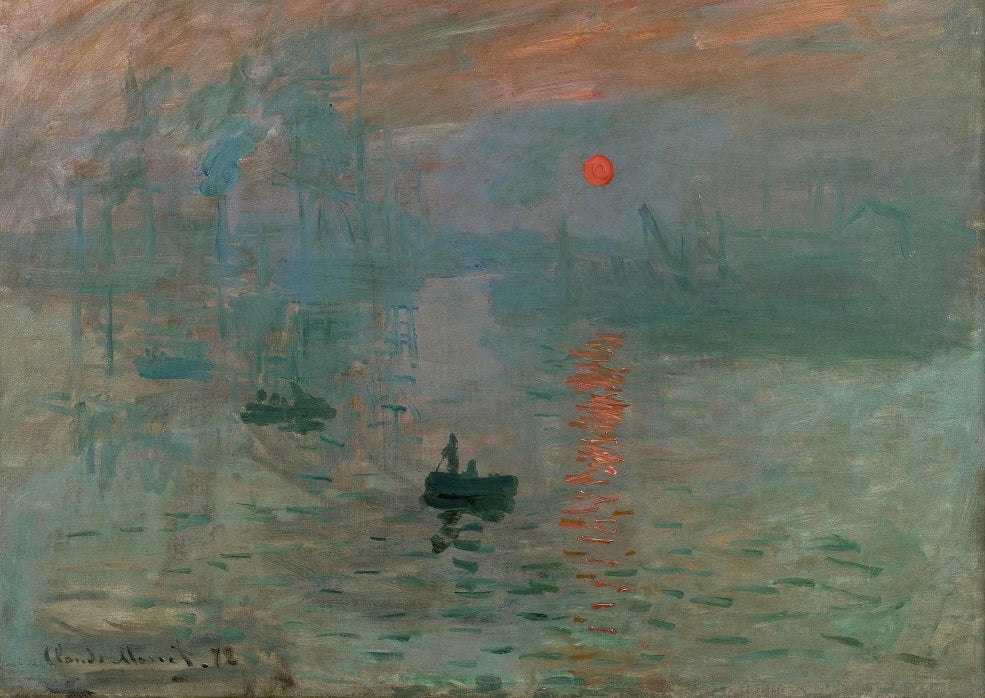
This famous painting, Impression, Sunrise, was created from a scene in the port of Le Havre. Claude Monet depicts a mist, which provides a foggy background to the work set in the French port. The orange and yellow hues contrast brilliantly with the dark ships, of which few, if any, details are immediately visible to the audience. It is a striking and candid work that shows the small boats in the foreground almost propelled by the movement of the water. This has been achieved, once again, by distinct brushstrokes that also show various colours 'glinting' on the sea. Although he is praised for his use of colour to depict depth while highlighting all the details, it is the fact that he inspired the name of the impressionist movement that made him famous worldwide.
Date of the work : 1872
Original dimensions : 48 × 63 cm
Place of conservation : Musée Marmottan Monet, Paris
Waterlilies

During the last two decades of his career, Monet devoted himself tirelessly to painting the famous water lily pond that he had designed and cultivated at his home in Giverny. In one extraordinary painting after another, he captured the constantly changing relationships between water, reflections, atmosphere, flowers and light that transformed the surface of the pond at every moment. These now iconic paintings affirm Monet's long-held belief in the primacy of vision and experience, but they do so in an entirely new and transformative pictorial language, even by the standards of the new century. The first paintings in the series were immediately acclaimed when Monet exhibited them in 1909. The Waterlilies paintings from 1914 onwards, on the other hand, were larger, bolder and much more personal. They proved to be authoritative and visionary only two decades after Monet's death, when American Abstract Expressionism was triumphing on the international art scene.
Date of the work : between 1897 and 1920
Original dimensions : varied
Places of conservation : Nombreux musées, dont Musée de l’Orangerie, Philadelphia Museum of Art et Metropolitan Museum of Art, New York
The Houses of Parliament, Sunset
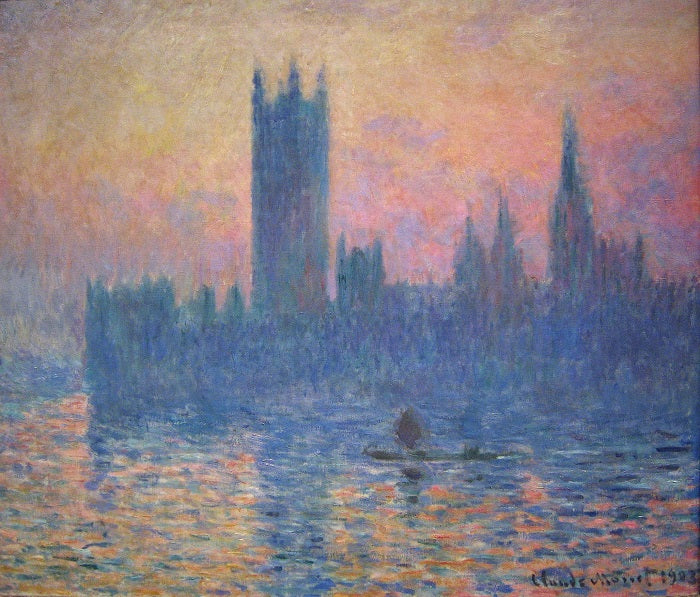
Claude Monet painted a series of pictures of the Palace of Westminster, the seat of the British Parliament, during his visits to London between 1900 and 1905. The paintings are all of the same size and from the same vantage point, Monet's window at St Thomas' Hospital overlooking the Thames. However, they are painted at different times of the day and in different weather circumstances.
In The Houses of Parliament, Sunset, Monet focuses on the atmosphere created when the architecture is placed near water and suffused with an eerie light. The Gothic spires of the Houses of Parliament almost break through the fog, but they are still reduced to a vague image that does not create a strong reflection in the water. The sun and its reflection cast a warm glow over the scene and provide two focal points, one at the top of the painting and one at the bottom. The whole work adheres to the aesthetic principles of Monet and impressionism, namely to be pleasing to the eye.
Date of the work : 1902
Original dimensions : 81.3 × 92.5 cm
Place of conservation : Private collection
San Giorgio Maggiore at Dusk
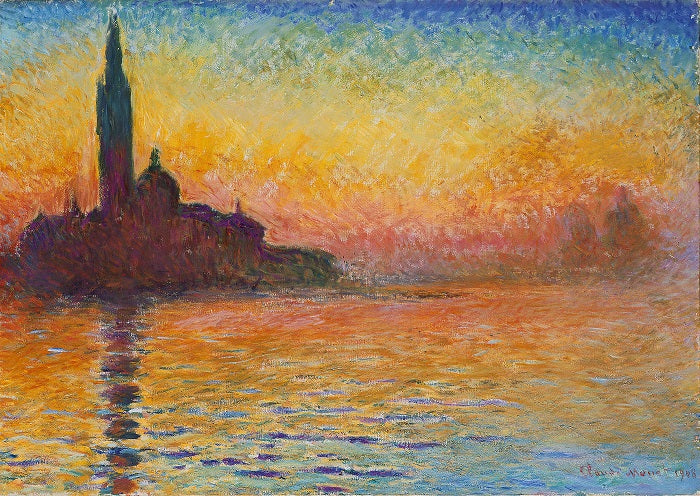
San Giorgio Maggiore at Dusk is an excellent landscape by Claude Monet. It was painted in the autumn of 1908 in Venice, where Claude Monet and his wife had travelled in their own chauffeur-driven car. They stayed first at the Palazzo Barbaro and then at the Hotel Brittania. It was there that he created this masterpiece.
The period in which Monet created this river or seascape painting corresponds to the time when he began to lose his sight due to grey cataracts. Like other Impressionists who were afflicted by pain or illness, suffering seems to inspire them to create their greatest works: Vincent van Gogh created his magnum opus Starry Night, while Monet, tormented by his psychological breakdown, painted this one. The vibrant blues, yellows and reds were used by Monet to depict the sunset.
Date of the work : entre 1908 et 1912
Original dimensions : 92,4 x 65,2 cm
Place of conservation : Musée
national de Cardiff, Royaume-Uni
Woman with a Parasol, facing right
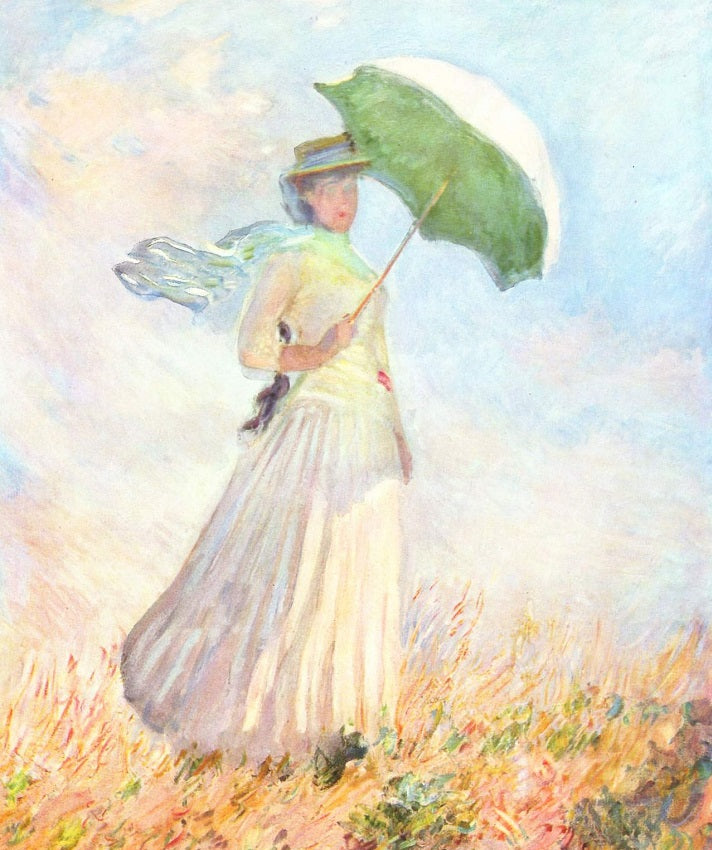
Monet's light, spontaneous brushstrokes create splashes of colour. The veil of his wife, who is depicted in this impressionist painting, is blown away by the wind, as is her billowing white dress; the billowing grass of the meadow is picked up by the green underside of her parasol. The undulating grass of the meadow is taken up by the green underside of her parasol. It is seen as if it were below, with a strong upward perspective on white, fluffy clouds in an azure sky.
The work is a genre painting of an everyday family scene, not a formal portrait. Woman with a Parasol, facing right was painted outdoors, in the open air, and quickly, probably in a single period of a few hours.
Date of the work : 1886
Original dimensions : 131 × 88 cm
Place of conservation : Musée d'Orsay, Paris, France
The Magpie

In the second half of the 1860s, Claude Monet began to experiment with snowy landscapes. This may have been a desire to paint more ephemeral scenes than his other landscapes, capturing the snow in the sunlight before it melts.
Monet was not the first artist to be captivated by snow. Gustave Courbet spent a great deal of time studying snow landscapes in his work.
During his career, Monet painted more than 100 snowscapes, The Magpie being the most famous of them. It is also Monet's largest snowscape.
Date of the work : 1869
Original dimensions : 89 x 130 cm
Place of conservation : Musée d'Orsay, Paris, France
Poppy Field
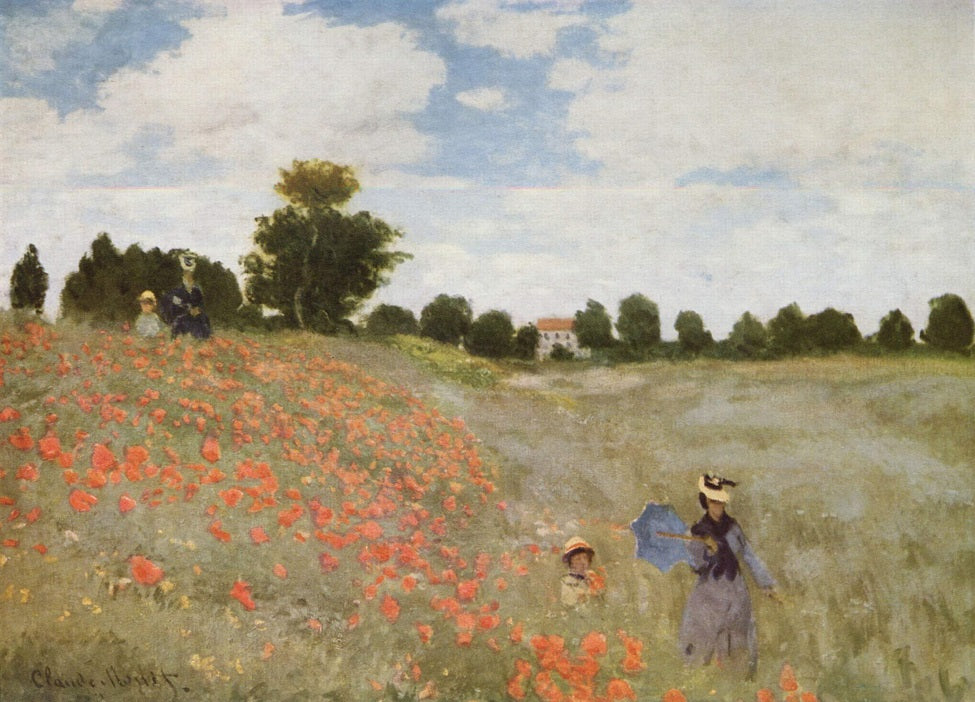
Claude Monet painted Poppy Field in 1873 where he settled in Argenteuil with his family until 1878. It was a period that gave the artist great fulfilment as a painter, despite the failing health of his wife Camille. It was at this time that Monet's plein air paintings began to develop and this particular work was exhibited at the first Impressionist exhibition in 1874.
This beautiful summer day is captured in all its glory with bright flowers contrasting with the glistening clouds in the clear blue sky. In the landscape, the mother and child in the foreground and another in the background are an excuse to draw the diagonal line that frames the painting. Two distinct colour zones have been identified, one dominated by red, the other by bluish green. The young woman carrying the umbrella and the child in the background could be the artist's wife, Camille, and their son, Jean.
Monet dilutes the contours and builds a colourful rhythm with patches of paint from a sprinkling of poppies; the disproportionate patches in the foreground indicate the primacy he gives to visual impression. A step towards abstraction has been taken.
Date of the work : 1873
Original dimensions : 50 x 65 cm
Place of conservation : Musée d'Orsay, Paris, France



